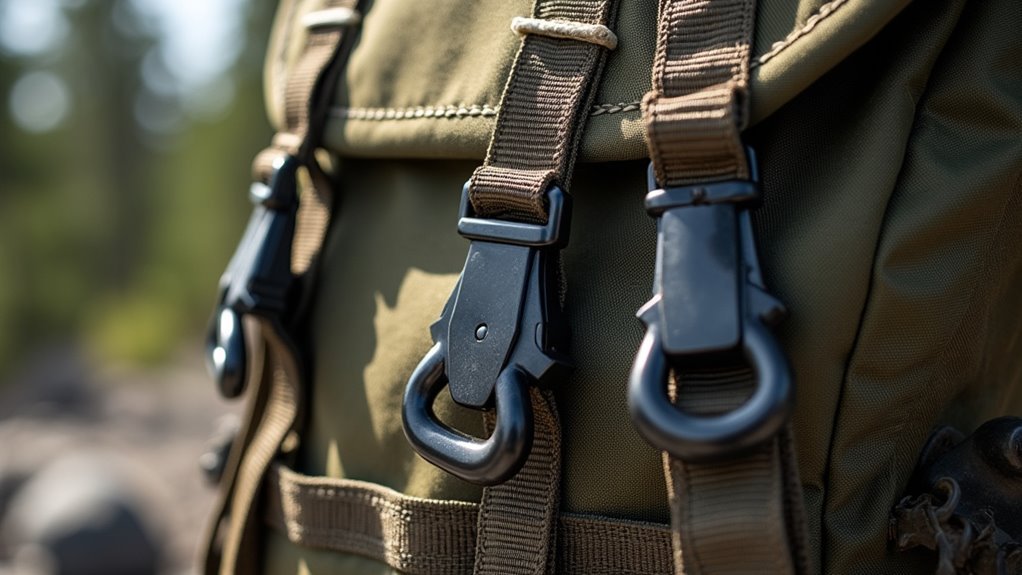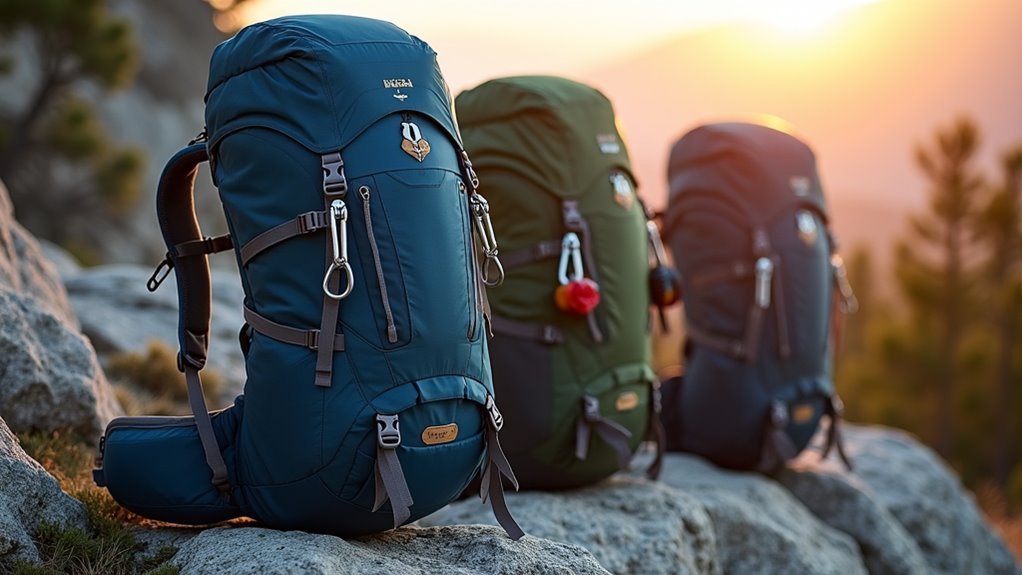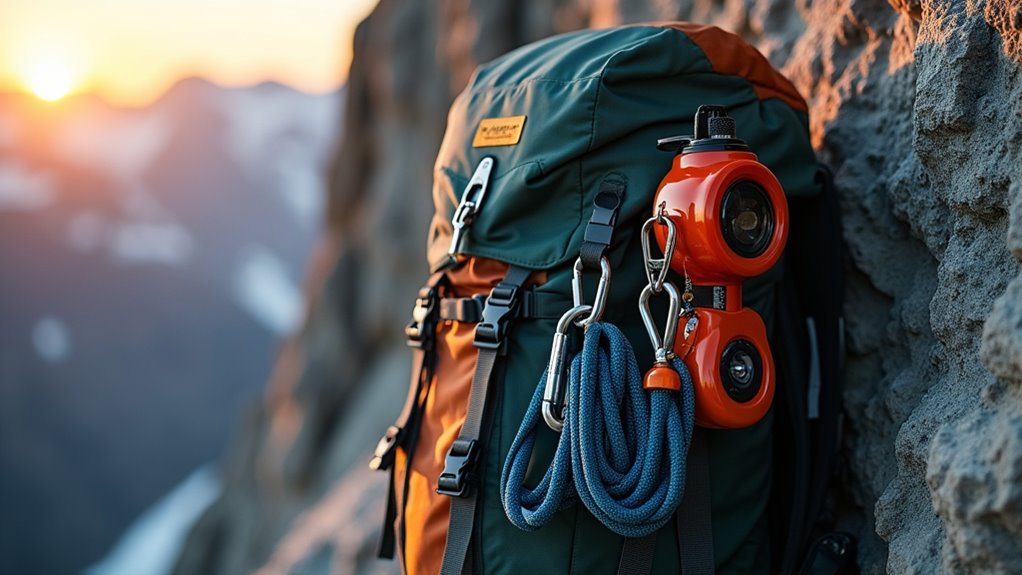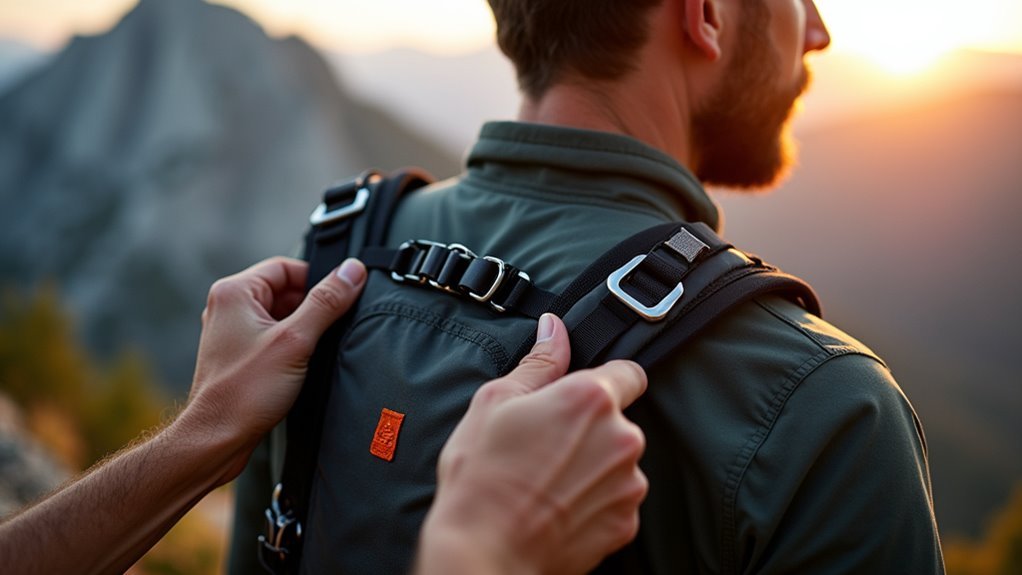I’ve discovered that D-rings are actually your backpack’s secret weapon for external gear organization. These metal or plastic attachment points let you clip on water bottles, carabiners, emergency whistles, and pouches without cramming everything inside. Metal D-rings handle heavy equipment like camera gear, while plastic ones work great for lighter items. They’re honestly a game-changer for keeping essential gear accessible during hikes or adventures. There’s so much more to optimizing their strategic placement.
What Are D-Rings and Why Do Backpacks Have Them

When you’re shopping for a new backpack, you’ve probably noticed those small metal or plastic rings attached to various spots on the exterior. These are D-rings, and they’re actually game-changers for anyone who values freedom and flexibility in their adventures.
Think of D-rings as your backpack’s external attachment points – they’re like having extra hands when you need them most. I’ve found they transform how you carry gear, letting you clip on water bottles, carabiners, or quick-access pouches without cramming everything inside. They’re simple hardware, but they release serious potential for customizing your pack’s functionality. Additionally, many hiking and outdoor backpacks feature adjustable straps that enhance comfort, making it easier to carry extra gear attached to those D-rings.
Plastic Vs Metal D-Rings: Choosing the Right Material
Now that you understand what D-rings can do for your pack, the material choice becomes your next decision point. I’ve found that plastic D-rings work perfectly for lightweight gear – think keys, small pouches, or maybe a whistle. They’re lighter and won’t scratch your other equipment. Metal D-rings, though? That’s where the real strength lives. When I’m hauling heavy camera gear or attaching my water bottle, I need that durability. Sure, they add a bit of weight, but honestly, the peace of mind is worth it when you’re miles from civilization. For added reliability, consider packs with material durability to ensure they can handle extended use in various conditions.
Popular Backpack Models Featuring D-Ring Systems

The outdoor gear market has delivered some standout performers when it comes to D-ring integration, and I’ve had the chance to test quite a few. The Oakley Men’s Utility Backpack really caught my attention with its strategic metal D-ring placement—perfect for heavy gear attachment. For fishing enthusiasts, well, the Osage River Deluxe Fishing Sling Bag practically revolutionizes how you carry tackle. I’m also impressed with Under Armour’s Big Logo 5.0 Backpack; those D-rings handle serious weight without breaking a sweat. Each model proves that thoughtful D-ring design isn’t just an afterthought—it’s essential for true outdoor freedom. Additionally, the use of high-denier nylon in these backpacks enhances their durability and ensures they can withstand the rigors of outdoor adventures.
Maximizing Storage by Attaching Gear Externally
Most hikers I know struggle with that age-old problem—fitting everything they need into their pack without creating an uncomfortable, bulky mess on their back. Well, D-rings actually solve this by letting you attach gear externally. I think it’s brilliant how you can clip on water bottles, camera bags, or fishing rod holders outside your pack. This frees up precious internal space for essentials. You know what’s even better? Your gear stays accessible without digging through everything. Maybe it sounds simple, but this external attachment system transforms how you organize your adventures—well, at least in my experience. Additionally, using compression sacks can further reduce bulk and help keep your sleeping bag compact during hikes.
Enhancing Safety Equipment Accessibility for Outdoor Adventures

When you’re scrambling up a rocky slope or maneuvering through dense forest, fumbling around in your pack for safety gear can be—well, let’s just say it’s not ideal. That’s where D-rings become your best friend. I’ve found they’re perfect for clipping essential safety items right where you need them.
| Safety Item | Why It Matters |
|---|---|
| Emergency whistle | Quick alert signal |
| Carabiner with rope | Instant secure attachment |
| Compass | Navigation without digging |
You can also thread hydration tubes through D-rings, keeping your system stable on rough terrain. Freedom means being prepared without being weighed down. Remember, safety tips such as testing gear before your trip can make all the difference in your outdoor adventures.
Securing Hydration Systems on Challenging Terrain
Traversing steep inclines or boulder-filled paths with a loose hydration tube flopping around is like trying to drink from a fire hose in a windstorm—messy and frustrating. I’ve learned that threading my hydration tube through strategically placed D-rings creates a stable drinking system that won’t betray me when I need it most. You know what’s liberating? Actually being able to hydrate without stopping every five minutes to untangle your tube from branches or rocks. Well, maybe it sounds minor, but these small freedoms add up to major confidence on challenging terrain. Utilizing hydration systems effectively not only improves efficiency but also enhances overall comfort during outdoor adventures.
Optimizing Strap Adjustment and Customization

Nothing beats a backpack that fits like it was custom-made for your torso, and that’s where D-rings at the end of straps become game-changers for achieving the perfect fit. I think most people don’t realize how transformative these little rings can be for comfort. You can attach additional straps with tri-bar adjusters between two D-rings, creating a completely customizable system. It’s like having a tailor for your pack. Whether you’re tall, short, or somewhere in between, D-rings let you dial in that sweet spot where weight distribution feels effortless and you’re ready for anything. Proper strap adjustment is essential for preventing shoulder and back pain, ensuring that you can enjoy your backpack without discomfort.
Transform Your Backpack Performance With Strategic D-Ring Use
Since discovering the true potential of strategic D-ring placement, I’ve completely changed how I approach backpack organization – and honestly, it’s made every outdoor adventure more efficient. Think of D-rings as your personal freedom multipliers. I strategically position my heaviest gear on lower D-rings for better balance, while keeping emergency items on side rings for quick access. My water bottle clips to the right, multi-tool to the left – it’s like having a perfectly choreographed dance. Well, maybe that sounds dramatic, but this system literally frees up 30% more internal space for what really matters. Additionally, maintaining a center of gravity close to the spine is essential for stability during your trek.
Frequently Asked Questions
How Many D-Rings Should I Add to My Existing Backpack?
I’d recommend adding 4-6 D-rings to your backpack – two on each side for gear attachment and 1-2 on the front for quick access items. You’ll have flexibility without overcrowding your pack’s exterior.
Can D-Rings Break Under Heavy Weight and What’s the Limit?
I’ve seen D-rings break when overloaded. Metal ones handle 50-100 pounds typically, while plastic ones fail around 20-30 pounds. You’ll want to check manufacturer specs and distribute weight across multiple attachment points.
Do D-Rings Affect Airline Carry-On Regulations and TSA Security Checks?
I’ve never encountered TSA issues with D-rings themselves, but they can snag items during security screening. Metal D-rings might trigger additional inspection, and protruding attachments could violate carry-on size restrictions if they extend beyond dimensions.
How Do I Properly Maintain and Clean D-Rings Over Time?
While adventures demand ruggedness, D-rings require gentle care. I recommend regular cleaning with mild soap and water, thoroughly drying afterward. For metal rings, I’ll occasionally apply light oil to prevent rust and maintain smooth operation.
Are There Specific D-Ring Brands That Offer Better Durability?
I’ve found that YKK and ITW Nexus consistently produce the most durable D-rings. These brands use superior materials and manufacturing processes that withstand heavy use and harsh conditions, giving you reliable gear attachment points for your adventures.